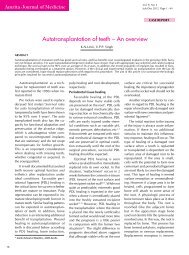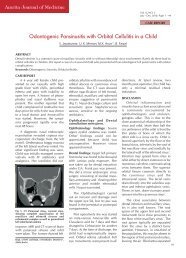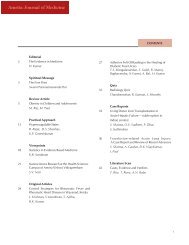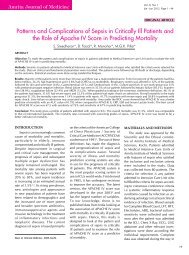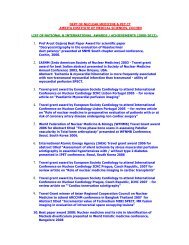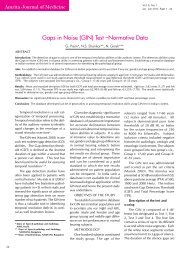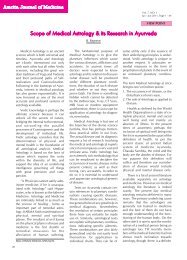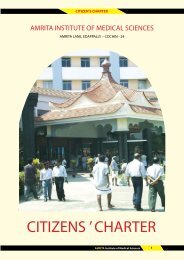Journal of Medicine Vol 4 - Amrita Institute of Medical Sciences and ...
Journal of Medicine Vol 4 - Amrita Institute of Medical Sciences and ...
Journal of Medicine Vol 4 - Amrita Institute of Medical Sciences and ...
Create successful ePaper yourself
Turn your PDF publications into a flip-book with our unique Google optimized e-Paper software.
<strong>Amrita</strong> <strong>Journal</strong> <strong>of</strong> <strong>Medicine</strong><br />
Multiple Endocrine Neoplasia 2B<br />
CT scan neck showed multiple nodules involving both<br />
lobes <strong>of</strong> thyroid with evidence <strong>of</strong> multiple enhancing<br />
lymphadenopathy in the subm<strong>and</strong>ibular level 2, 3, 4 right<br />
side <strong>and</strong> level 1 <strong>and</strong> 5 on both sides. The 24-hour urinary<br />
metanephrine <strong>and</strong> VMA were surprisingly normal. CT<br />
abdomen showed a 6.2 x 5.8 cm sized heterogeneously<br />
enhancing lesion with central necrosis on the left adrenal<br />
gl<strong>and</strong>. Right adrenal gl<strong>and</strong> also showed evidence <strong>of</strong> 1.2 x<br />
1.3 cm enhancing nodule (Fig.3).<br />
Fig.3: CT chest showing bilateral adrenal mass lesion<br />
In spite <strong>of</strong> normal VMA <strong>and</strong> metanephrine patient<br />
underwent laparoscopic bilateral adrenalectomy in view<br />
<strong>of</strong> presence <strong>of</strong> bilateral adrenal mass <strong>and</strong> strong possibility<br />
<strong>of</strong> the pheochromocytoma in this clinical setting.<br />
Before surgery he was adequately prepared with alpha<br />
blockade <strong>and</strong> given peri <strong>and</strong> postoperative steroid coverage<br />
<strong>and</strong> later on, after adrenalectomy, he was stabilised<br />
on oral hydrocortisone <strong>and</strong> fludrocortisone. His diagnosis<br />
was confirmed with histopathology showing bilateral<br />
pheochromocytoma. After that he underwent total thyroidectomy<br />
with bilateral modified radical neck<br />
dissection. Histopathology confirmed the diagnosis <strong>of</strong><br />
MTC with metastasis to bilateral cervical lymph nodes.<br />
Post operatively he was started on L-thyroxine replacement<br />
<strong>and</strong> then fractionated radiotherapy was given to<br />
tumor bed <strong>and</strong> nodal areas.<br />
MUTATION ANALYSIS<br />
His blood was sent for MEN2B mutation analysis<br />
which was done by PCR DNA sequencing which revealed<br />
a heterozygous M918T mutation in exon 16 <strong>of</strong> RET protooncogene<br />
<strong>of</strong> chromosome 10. His diagnosis <strong>of</strong> MEN 2B<br />
was confirmed.<br />
CARRIER ASCERTAINMENT<br />
His 3-year-old son’s blood was also sent to the same<br />
laboratory <strong>and</strong> it also yielded the same M918T mutation.<br />
The son had few mucosal neuromas in the tongue.<br />
His BP was normal <strong>and</strong> basal calcitonin was 14 pg/mL.<br />
He underwent total thyroidectomy with central compartment<br />
dissection.<br />
Histopathological examination showed C cell hyperplasia.<br />
His urinary metanephrines <strong>and</strong> CT abdomen are<br />
normal now.<br />
DISCUSSION<br />
Multiple endocrine neoplasia syndromes are classified<br />
into two main categories: MEN type 1 <strong>and</strong> MEN<br />
type 2<br />
MEN 2 includes two forms:<br />
MEN 2A (Werner’s syndrome)<br />
-Medullary thyroid cancer (100%)<br />
-Pheochromocytoma (50%) <strong>and</strong><br />
-Parathyroid tumors (10-20%)<br />
MEN2A variants<br />
-MEN2A with cutaneous lichen amyloidosis<br />
-Familial Medullary thyroid cancer<br />
-MEN2A with Hirschsprung’s disease<br />
MEN2B<br />
-Medullary thyroid cancer (100%)<br />
-Pheochromocytoma (50%)<br />
-Ganglioneuroma <strong>and</strong> mucosal neuromas (>98%)-<br />
-Marfanoid habitus (>95%)<br />
MEN2 related syndromes are uncommon with probably<br />
fewer than 1500 kindreds worldwide 1 . Fewer cases<br />
<strong>of</strong> MEN2 have been reported in Asia, except for Japan,<br />
where many families exist 2 . They are autosomal dominant<br />
conditions due to activating mutations <strong>of</strong> extracellular<br />
cysteine domain or intracellular tyrosine kinase domain<br />
<strong>of</strong> RET protooncogene with the result that the intracellular<br />
tyrosine kinase is activated constitutively in the<br />
absence <strong>of</strong> its natural lig<strong>and</strong> ‘Glial derived nerotropic<br />
factor’. MTC occurs in all the patients <strong>of</strong> MEN2B. In<br />
general MTC develops earlier <strong>and</strong> it is more aggressive in<br />
MEN2B compare to MEN2A. Children have been described<br />
with metastatic MTC shortly after birth 3,4 . Death<br />
related to complications <strong>of</strong> metastatic MTC may occur<br />
before onset <strong>of</strong> the third decade 5,6 . Pheochromocytomas<br />
in MEN2B occur in more than 50% <strong>of</strong> affected individuals<br />
<strong>and</strong> also may develop at an early age. Mucosal<br />
neuromas located on the tongue tip, within the lips, <strong>and</strong><br />
on the eyelids makes for a characteristic facies identifiable<br />
even in the childhood 7 . But because <strong>of</strong> the rarity <strong>of</strong><br />
the condition <strong>and</strong> unawareness amongst the doctors it is<br />
<strong>of</strong>ten missed as in the present case.<br />
The primary goal <strong>of</strong> screening for MEN2 is to identify<br />
<strong>and</strong> treat the several manifestations <strong>of</strong> MEN2 before they<br />
become life threatening. A secondary goal is to provide<br />
genetic counseling to family members about the potential<br />
for transmission to the next generation. The two<br />
38



